Think you can’t bake artisan sourdough bread at home? Think again! Sourdough Bread: a Beginner’s guide is your go-to recipe resource for simple, easy sourdough bread without kneading. Make the dough in the morning or at night- it will come together in under 10 minutes.
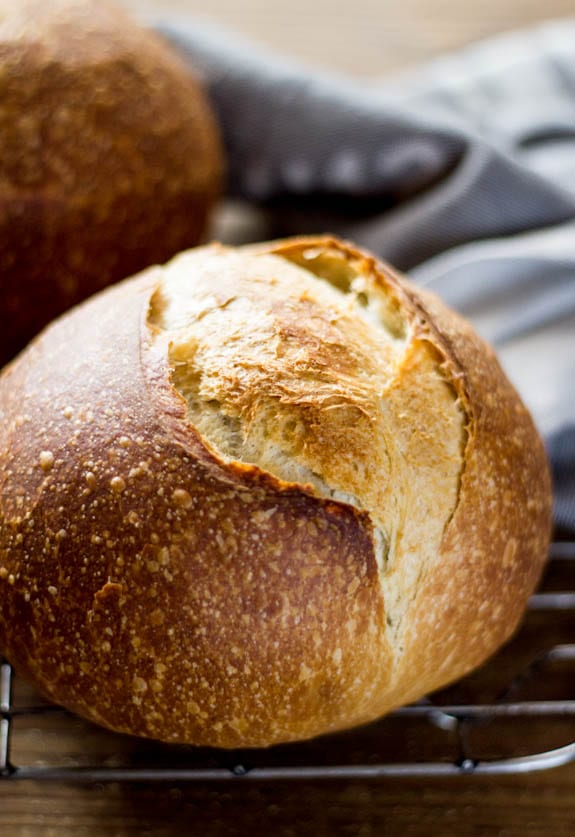
In 2013, my resolution was to bake more bread.
I researched, tested and baked countless loaves with both good and mixed results. My journey began with this no-knead artisan bread recipe and eventually, I worked my way up to the holy grail: Sourdough. My passion for creating easy sourdough bread recipes and preserving traditional culinary arts inspired my bestselling book Artisan Sourdough Made Simple which has connected me to like-minded bakers all over the world!
So, if you’re curious about sourdough bread and don’t know where to begin, you’re in the right spot. This sourdough bread recipe has been THE MOST popular recipe on my blog for over a decade and continues to earn millions of pageviews a month. Welcome to the journey.
What You’ll Learn
In this tutorial, you’ll learn how to make simple sourdough bread with step-by-step instructions and videos for guidance. There’s no kneading involved, and a bread machine or a stand mixer is not required. My sourdough bread recipe is perfect for beginners. I’ll explain a complex topic in simple terms without the stress!
But before you dive in, here’s a secret: sourdough bread is more than just a recipe… it’s an understanding.
There are similar sourdough bread recipes out there and yet no two loaves look alike. The process is all about method, timing and personal touch. Use this tutorial as a guide and make your own adjustments as you go. Once you have a few loaves under your belt, the process will become an imminent rhythm, and in the end, you will have created your very own masterpiece that is the ultimate reward. Just don’t forget to eat your mistakes (might I suggest homemade sourdough breadcrumbs)?
Jump To
- Sourdough Bread Recipe
- Step by Step Instructions
- Sourdough Starter 101
- Sample Baking Schedule
- Sourdough FAQ
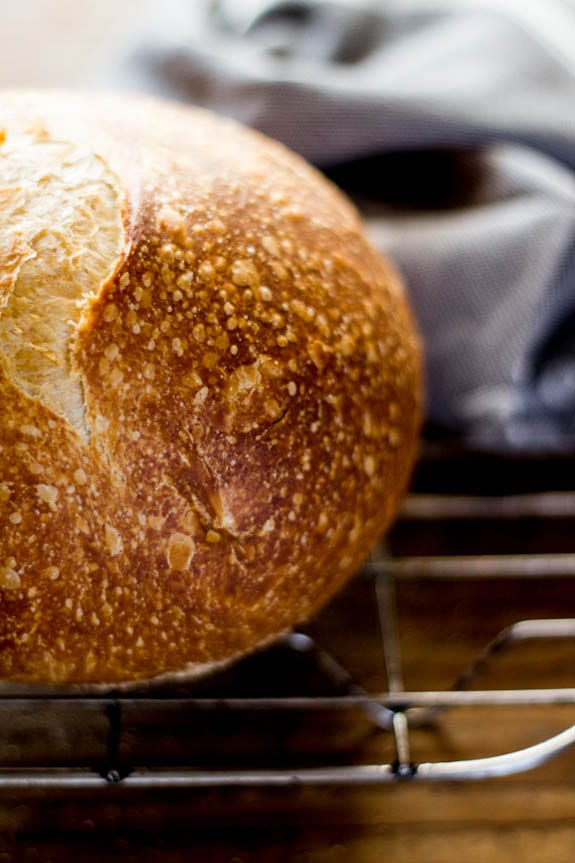
So, What is Sourdough?
In a nutshell, sourdough is slow-fermented bread.
It’s unique because it does not require commercial yeast in order to rise. Instead, sourdough bread is made with a live fermented culture a sourdough starter, which acts as a natural leavening agent.
Sourdough is known for its characteristic tangy flavor, chewy texture and crisp, crackly crust. From a health standpoint, it dominates when compared to supermarket loaves. The naturally occurring acids and long fermentation help to break down the gluten, making it more digestible and easy for the body to absorb. And it tastes darn good!
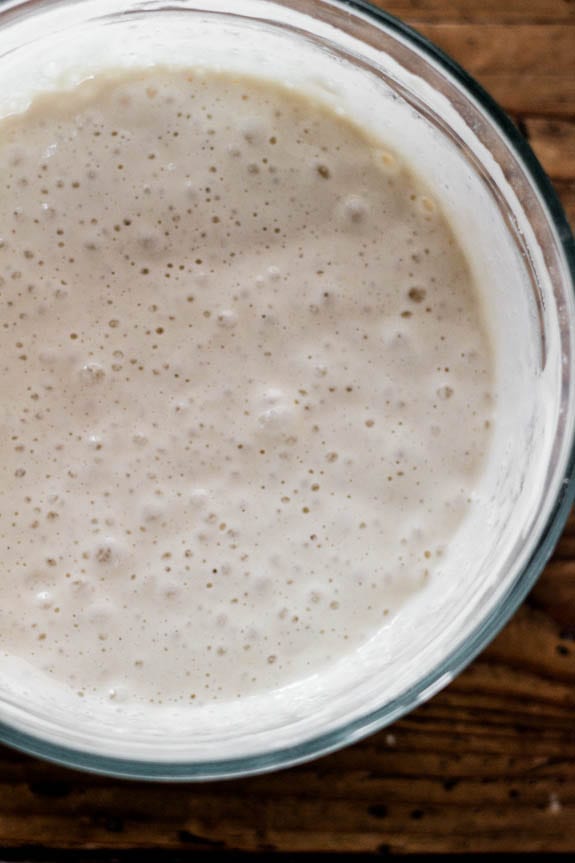
Sourdough Starter 101
Before you begin, you’ll need a sourdough starter.
Simply put: a sourdough starter is a live culture made from flour and water.
Once combined the mixture will begin to ferment, cultivating the naturally occurring wild yeasts and bacteria present within the mixture. A small portion of this culture is used make your bread dough rise.
But it doesn’t stop there.
Your starter must be kept alive with regular feedings of flour and water to maintain its strength for maximum rising power.
How to Feed your Sourdough Starter
Every baker has their own method, and with practice you’ll eventually develop your own routine.
Here’s my method: I pour off some of the culture (about half) and then feed what’s left in the jar with equal weights of flour and water. I whisk well with a fork until it’s lump-free. Then, I let it rest at room temperature or in a warm spot (75-80º F/ 24-26º C is ideal) until it becomes bubbly and active.
PS: I use this the jar for my sourdough starter and I LOVE it.
When is my Starter Ready To use?
Your stater is ready to use when it becomes bubbly and doubles in size.
This can take anywhere from 2-12 hours or more depending on temperature (the warmer the better) and the condition of your starter. Be patient!
Float Test: If you’re still unsure whether it’s ready to use drop a small amount, about 1 tsp, into a glass of water. Do this when the starter is a peak height before it collapses. If it floats to the top it’s ready to use. If it sinks, your starter should be fed again.
Where to Obtain a Sourdough Starter
All sourdough starters are different.
They can be made from scratch, purchased online, or if you’re lucky, someone will share a portion of their starter with you.
Starters range from thick to thin in texture and can be made with a variety of flours. I use two different starters; one is homemade and the other was a gift from my friend Celia. She dried a portion of her starter and mailed it all the way from Sydney, Australia.
How To Use A Starter
After you’ve fed your starter and it’s bubbly and active, pour the amount you need out of the jar to weigh or measure for your recipe. That’s it.
Then, don’t forget to feed what’s left in the jar with more flour and water to keep the process going.
Any leftover sourdough starter can be used to make sourdough discard recipes, even my homemade sourdough pasta.
Storage Options
If you only bake a few times a month, keep your starter in the fridge and feed it once a week. If you’re an avid baker, store your starter at room temperature and feed it at least once a day.
Looking for more info on sourdough starters? Check out Feeding Sourdough Starter: My Best Tips & Tricks & Sourdough Discard 101: Recipes & Faqs Answered.
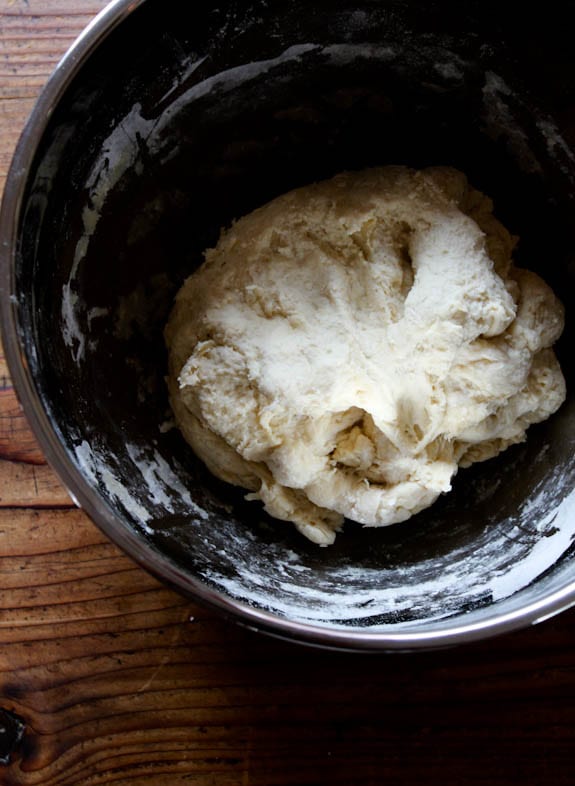
How to Make Sourdough Bread: Step-By-Step Guide
Step #1: Mix The Dough
Combine the following ingredients in a large bowl (I use a fork):
- 250 g water
- 150 g bubbly, sourdough starter
- 25 g olive oil
Add:
- 500 g bread flour (such as King Arthur)
- 10 g fine sea salt
Squish the mixture together with your hands until the flour is fully absorbed. The dough will feel dry, rough and shaggy.
Cover the bowl with plastic wrap, reusable wax wrap, or a very damp kitchen towel and let rest or ‘autolyse’ for about 30 minutes. After the dough has rested, work it into a ball directly in the bowl (it doesn’t have look perfect).
TIP: For best results, weigh all of your ingredients with a digital kitchen scale. Measuring cups are not as accurate. Please visit Sourdough FAQ for more details.
What is Autolyse?
This is the first resting period right after you mix the dough.
It jumpstarts gluten development without kneading. Strong gluten = good bread.
For timing, autolyse can range anywhere from 15 minutes to 1 hour or more depending on the type of bread you’re making and your own personal baking schedule. A minimum of 30 minutes works best for this recipe. However, when time permits, I’ll let it go for an hour. The dough will become more soft and manageable to work with afterwards.
A Note on Salt: some bakers prefer to add salt only after autolyse because it might slow down the gluten development. I’ve followed this technique for years, but no longer do so. I prefer to mix everything all at once. It’s practical, effective and produces excellent loaves (plus, you won’t forget to add the salt later on!). I’ll leave the choice up to you.

Step #2: Bulk Rise
Now the dough is ready to rise.
Cover the bowl and let rise at room temperature, about 68-70 F.
How Long will it take?
The dough is ready when it has doubled in size and no longer looks dense.
This can take anywhere from 3-12 hours depending on your current room temperature, the potency of your sourdough starter and the specifics of your surrounding environment.
For example, in the summer the dough can take anywhere between 2-4 hours @ 85º F/ 29º C. In the winter, it will take longer about 10-12 hours @ 68º F/ 20º C. Temperature controls time.
And remember: because sourdough bread does not contain instant yeast it will take longer to rise. Watch the dough and not the clock. Be flexible.
Optional Step: Stretch and Fold the Dough
About 30 minutes into the bulk rise, you have the option to perform a series of ‘stretch & folds’ to strengthen the bread dough {click here for a step-by-step tutorial}. Although it’s not mandatory, this technique will add height and structure to the finished loaf and it’s fun to do.
Watch the video below!
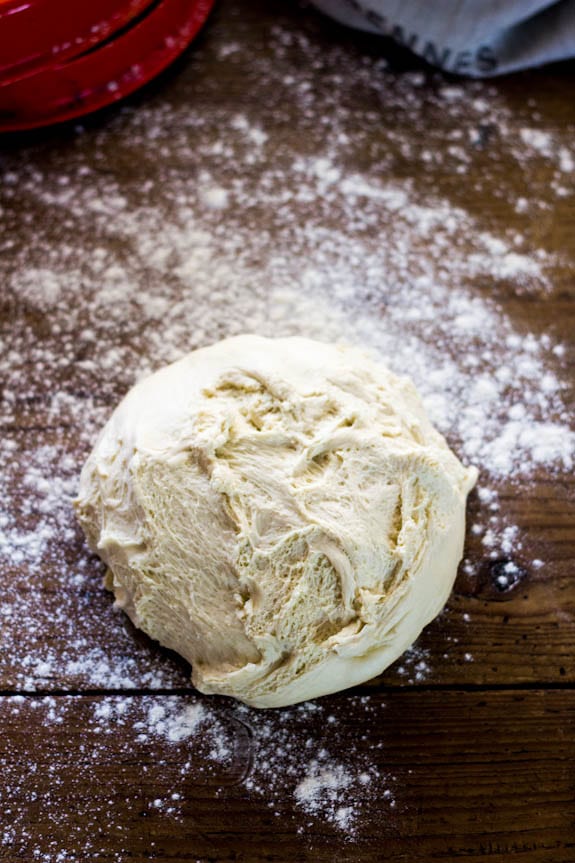
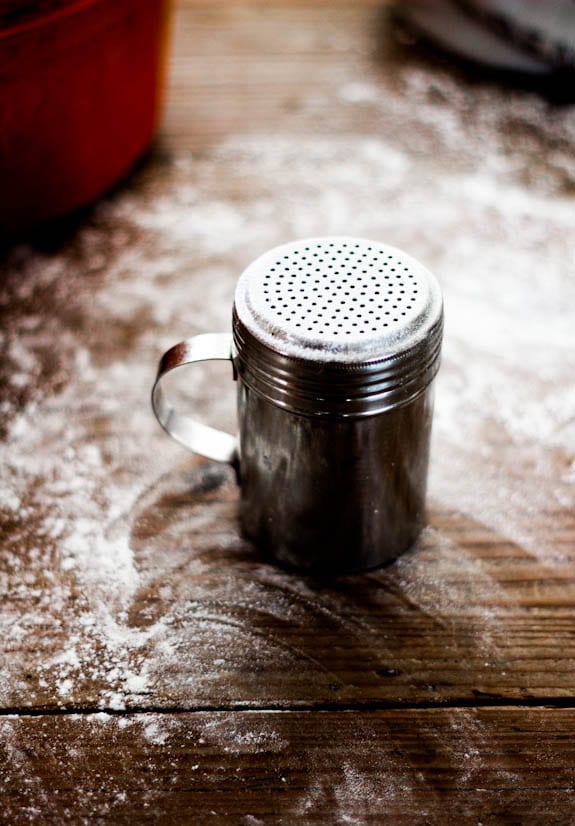
Step #3: Divide & Shape The Dough
Remove the dough onto a lightly floured surface.
Cut the dough in half to make 2 loaves, or leave it whole for a single loaf.
How to Shape a Round Sourdough Boule (Loaf)
Starting at the top, fold the dough over toward the center. Give it a slight turn, and then fold over the next section of dough. Repeat until you have come full circle. Or, use the envelope shaping technique outlined below.
Watch the video!
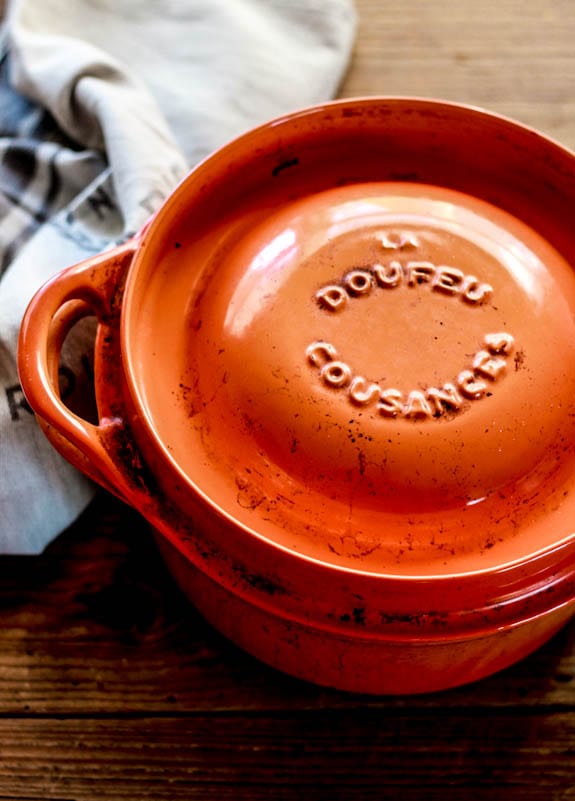
Step #4: Choose a Baking Pot
I bake my sourdough bread in a Dutch oven.
You can also try the Challenger Bread Pan, another vessel I use for baking, that can accommodate both round and oval shaped loaves.
The pot traps in heat and moisture which is essential to achieving artisan style bread at home.
Steam plays a key role in how the bread will open up or ‘bloom’ while baking and the Dutch oven helps to control this process.
You can use any oven safe pot that can heat up to 450º F/ 232º C (including the lid and handles).
TIP: In the past, I’ve tried baking on pizza stones and cookie trays with no luck. The crust would harden too quickly, forcing the bread to tear on the bottom and sides. I used various steaming methods to remedy this, however I found them to be extremely cumbersome and not realistic for everyday use. Nothing worked. The lack of moisture in my home oven was evident and using a pot for baking was the only practical solution.
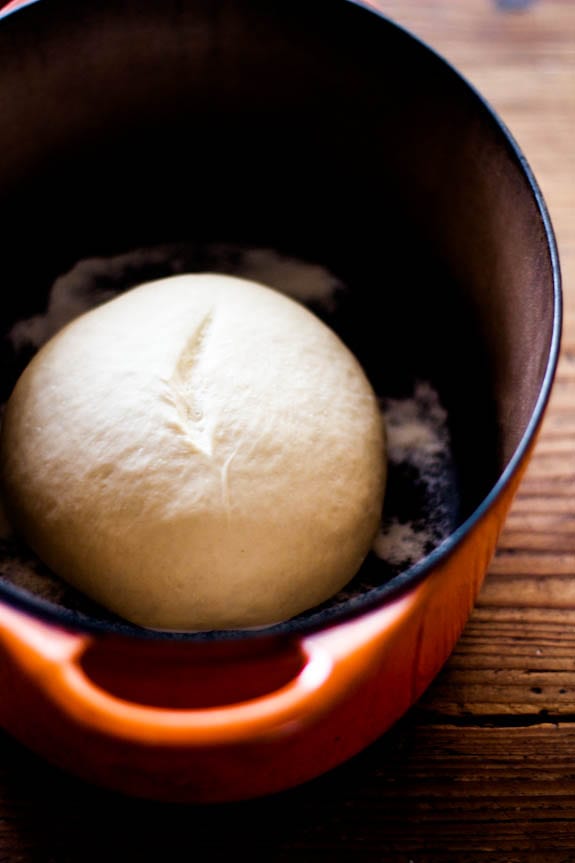
Step #5: Second Rise
After shaping the dough, it needs to rise again.
Generously coat the bottom of your Dutch oven with cornmeal (or line the bottom with non-stick parchment paper instead) and place the dough inside.
This time, the dough will rise for a shorter period about 30 minutes- 1 hour.
The dough is ready when it’s puffy and no longer dense. It does not need to double in size.
Preheat your oven to 450º F/ 232º C during the tail end of the second rise.
TIP: Instead of doing a free form second rise in the Dutch oven, use a cloth lined proofing basket or 8-inch bowl instead. Either option will contain the dough and hold its shape properly during the second rise.
Step #6: Score the Dough
After the second rise, and right before the dough goes into the oven, make a slash about 2-3 inches long down the center of the dough.
This allows the steam to escape and for the dough to expand during baking.
You can use a small serrated knife, paring knife or bread lame.
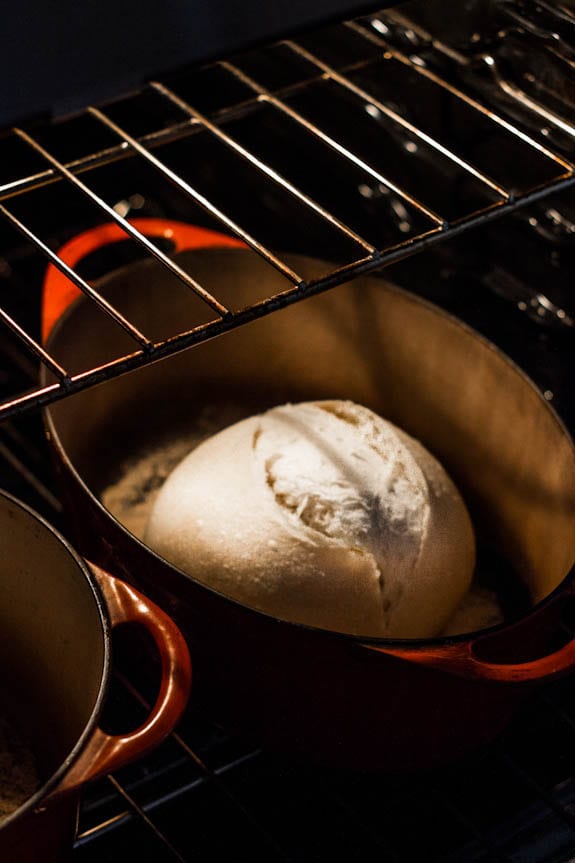
Step #7: Bake the Sourdough Bread
Place the lid on top of the pot and reduce the oven temperature to 400º F/ 204º C.
Bake on the center rack for 20 minutes.
When 20 minutes is up, remove the lid. Your bread will be pale and shiny like the picture above.
Continue to bake (uncovered) for an additional 40 minutes or until deep, golden brown. The internal temperature should read 205-210º F/ 96-98º C.
Cool on a wire rack for at least a 1 hour before slicing. Be patient!
If you cut into it too soon, the texture will be gummy…
TIP: During the last 10 minutes of baking, crack open the oven door (optional). This allows the moisture to escape, leaving your sourdough bread with a crisp crust. Alternatively, remove the bread from the pot and let it bake directly on the rack. The latter produces a more crisp crust.
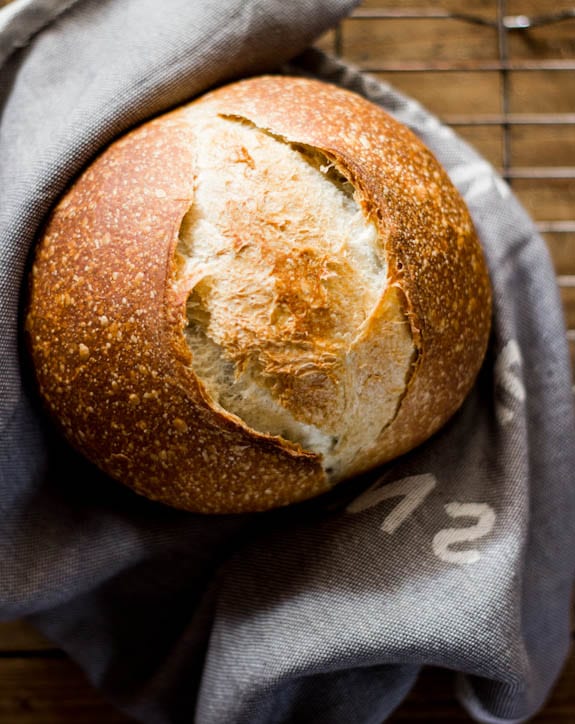
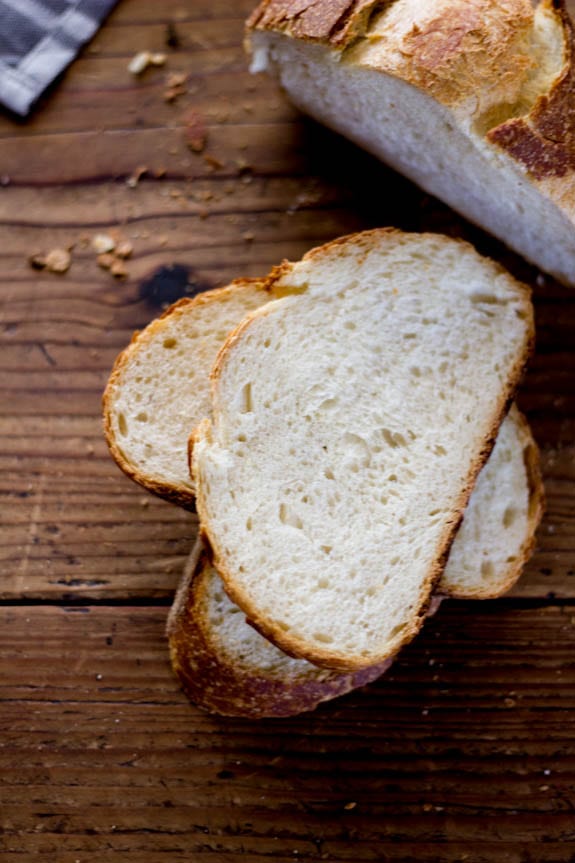
Additional Sourdough Recipes & Resources
Sourdough Starter:
- Beginner Sourdough Starter {Recipe}
- Feeding Sourdough Starter: My Best Tips & Tricks
- Sourdough Discard 101: Recipes & Faqs Answered
Sourdough Bread Recipes:
- Beginner’s Guide to Sourdough Focaccia Bread
- Best Sourdough Pizza Crust (No steel or stone!)
- Best Sourdough Pasta (1 hour or Overnight)
- Light Whole Wheat Sourdough
- Easy Sourdough Sandwich Bread
- Soft Sourdough Cinnamon Rolls
- Best Sourdough Pancakes
Sourdough Bread Tips & Techniques:
- How to Stretch and Fold Sourdough {Video}
- How to Shape a Round Sourdough Boule {Video}
- Why Won’t My Sourdough Bread Rise?
- Bread Flour vs. All Purpose Flour: What’s the Difference?
Sourdough Tools & Supplies:
Baking Schedule
- Friday Evening: Feed your starter, cover the jar, and leave it on the counter overnight. If you keep your starter in the fridge, it might need two feedings to perk back up (feed it in the morning & in the evening).
- Saturday Morning: Check your starter: if it’s alive and bubbling, you can make the dough to rise during the day. Or, feed it again in the afternoon to make the dough in the evening for an overnight rise. Remember to use the float test mentioned above to make sure your starter is ready to use.
- Saturday Morning/Evening (or whenever your starter is ready): Make the dough. Leave on the counter to bulk rise at room temperature. In the summer, if your dough rises quickly and you’re not ready to bake, cover the whole bowl with lightly oiled wrap and chill until ready to use.
- Sunday Morning: cut and shape the dough. Place in Dutch oven for second rise. Slash. Bake. Cool. Eat.
Sourdough Bread Recipe
Print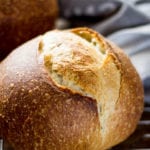
Sourdough Bread: A Beginner’s Guide
- Prep Time: 13 hours
- Cook Time: 1 hour
- Total Time: 14 hours
- Yield: 1 loaf
- Category: Sourdough Bread Recipes
- Method: Oven-Baked
- Cuisine: American
- Diet: Vegan
Description
This beginner sourdough recipe is perfect for bakers looking to jump right in! It’s is a low-hydration dough, meaning it will yield a ‘tight’ crumb (small holes). It is great for sandwiches and toast.
Ingredients
- 150g/ 5.35 oz bubbly, active sourdough starter
- 250g/ 8.80 oz warm water, preferably filtered*
- 25g/ .90 oz olive oil
- 500g/ 17.65 oz bread flour (not all purpose flour)
- 10g/ .4 oz fine sea salt
- fine ground cornmeal, for dusting
*For a more soft and pliable dough, you can increase the water up to 300 g- 325 g total. Please use a cloth lined bowl (instead of the Dutch oven for the second rise).
**You will need a 5 1/2 or 6 quart Dutch oven for baking
***This recipe was tested with King Arthur Bread Flour, Gold Medal Bread Flour, Pillsbury Bread Flour
Instructions
Make the Dough
Whisk the starter, water, and olive oil in a large bowl. Add the flour and salt. Squish everything together with your hands until all of the flour is absorbed. The dough will be dry and shaggy. Cover the bowl with plastic wrap, reusable wrap or a clean, very damp kitchen towel. Let rest (autolyse) for 30 minutes or up to 1 hour, if preferred.
After the dough has rested, work the dough in the bowl into a rough ball, about 15 seconds.
Bulk Rise
Now the dough needs to rise.
Cover the bowl with wrap or a very damp kitchen cloth. Let rest in a warm spot to rise. The dough is ready when it no longer looks dense and has doubled in size. This can take anywhere from 3-12 hours depending on the temperature of your ingredients, the potency of your starter and surrounding environment. For example, in the summer rise times can take anywhere between 2-4 hours @ 85º F/ 29º C whereas in the winter, the dough will take about 10-12 hours @ 68º F/ 20º C.
Optional Step: Stretch & Fold the Dough
During bulk rise, you have the option to perform a series of ‘stretch & folds’ to strengthen the dough. Start 30 minutes into the bulk rise. Gather a portion of the dough, stretch it upwards and then fold it over itself. Rotate the bowl ¼ turn and repeat this process until you have come full circle to complete 1 set. Do this once or twice spaced about an hour apart. Although this step is not mandatory, it will increase the total volume and height of your bread. Click here for a step-by-step video tutorial.
Cut & Shape the Dough
Divide your work surface in half; lightly flour one side (for cutting) and leave the other half clean (for shaping).
Remove the dough from the bowl, and place onto the floured section so that it does not stick. You do not need to ‘punch down’ the dough; it will gently deflate as you fold and shape it.
Cut the dough in half to make 2 loaves, or leave it whole for a single loaf.
To shape, use a bench scraper to move your dough to the non-floured section (if there is any flour present, it will be difficult to shape- brush away any excess). Starting at the top, fold the dough over toward the center. Give it a slight turn, and then fold over the next section of dough. Repeat until you have come full circle.
Then flip the dough over and place it seam side down. Using your hands, gently cup the sides of the dough and rotate it, using quarter turns in a circular motion. You can also pull it towards you to even out the shape. Repeat this process until you are happy with its appearance. *See note below.
Second Rise
Now the dough needs to rise again, but for a shorter period of time.
Coat the bottom of your Dutch oven with cornmeal. Alternatively, use parchment paper to prevent sticking (this is what I do, now). Place the dough inside for a second shorter rise, about 30 minutes to 1 hour and cover with the lid of the pot or a very damp cloth. The dough ready when it is slightly puffy but not double in size.
Preheat your oven to 450º F/ 232º C towards the tail end of the second rise.
Score the Dough
Right before your bread goes into the oven, make a shallow slash about 2-3 inches long (or more) in the center of the dough. Use a bread lame, sharp pairing or a small serrated steak knife. The cut should be about 1/4-inch deep.
Bake the Dough
Place the bread into the oven on the center rack (lid on) and reduce the temperature to 400° F/ 204° C. Bake for 20 minutes. Remove the lid, and continue to bake (uncovered) for an additional 40 minutes or until deep, golden brown. Keep in mind that all ovens are different; you might have to make minimal adjustments to these temperatures.
You can also take the internal temperature of your bread to double check that it is done. For sourdough, it should read about 205-210º F/ 96-98º C.
Remove the bread from the oven, and cool on a wire rack for at least an hour before slicing. Don’t cut too soon or else the inside will have a gummy texture!
Notes
When shaping, the idea is for the dough to catch enough surface tension on a non-floured area in order to create a tight ball. If there is flour present, it will slide around… and drive you nuts.
Sourdough FAQ
1.) I only have all purpose flour. Can I still make this recipe?
For best results, use bread flour for this dough. If you only have all purpose try my Artisan Sourdough with All Purpose Flour instead.
2.) Can I add whole wheat flour to this recipe?
You can, but I wouldn’t. The dough will be too dry and dense without adjusting the water quantity. Try my Light Whole Wheat Sourdough for more whole grain goodness.
3.) Your beginner recipe here uses 150g of sourdough starter. The Everyday Sourdough in your book uses only 50g. What’s the difference? And why?
- When I first learned how to bake sourdough bread, I used 150g of starter. Overtime, it was too much to maintain (especially when doubling and tripling recipes). So, I scaled down. That’s why most recipes in my book Artisan Sourdough Made Simple include 50 g of starter instead. One amount is neither right or wrong; it’s just a matter of preference.
4.) What’s the purpose of olive oil in this recipe?
Adding olive oil to sourdough was the method I followed when I first learned how to bake. The natural fat emulsifies the dough and makes a plush crumb.
5.) Why do some of your recipes call for the second rise in a Dutch Oven? And others in a cloth- lined bowl?
The freeform Dutch oven second rise will only work with dry, low hydration doughs (like this one) because it will not spread out too much. On the flip side, when working with wet, high hydration doughs you’ll need to use a cloth-lined bowl sprinkled with flour to holds it shape. Otherwise, it will spread.
6.) Why don’t you preheat your Dutch oven before baking?
Because this recipe follows a freeform second rise directly in the baking pot, it cannot be preheated beforehand. The dough will begin to cook before going into the oven!
However, if you are doing the second rise in a cloth-lined bowl as mentioned in question #5 above, you can preheat the pot if you’d like. When bread dough is placed into a hot pot it begins to expand instantly which is great for the overall shape and structure of the bread. And in fact, I use to follow this technique when I first started baking. But overtime, I found the preheat to be too cumbersome for small kitchens with little kids running around. Plus, I kept burning my wrists. Long story short: you can achieve comparable results without the preheat. The choice is up to you.
7.) Can I halve the dough to bake 2 loaves? If so, what will that do to the baking time?
Yes, you can definitely halve this recipe. Bake for 20 minutes (lid on) and 30 minutes (lid off). Check at the 45 minute mark.
8.) If I halve the recipe, where should I store the second dough if I’m not baking at the same time?
Store the second dough in the fridge until ready to bake. Place the dough in a cloth-lined floured bowl (seam side down) and use the cloth overhang to cover it. If the dough is in the fridge for longer than 1 hour, rest at room temperature while the oven heats up.
9.) How do I get the dough out of the cloth-lined floured bowl?
Open up the cloth overhang to reveal the dough in the bowl. Place a piece of parchment paper on top of the dough. Flip the bowl over. Remove the bowl and cloth. The dough is now smooth side up and ready to be scored.
10.) Can I have the measurements for this recipe in cups, please?
- 3/4 cup bubbly, active starter
- 1 cup + 1 tbsp warm water
- 2 tbsp olive oil
- 4 cups bread flour
- 1 1/2 tsp fine sea salt
NOTE: Weight and volume measurements are not equivalent, only approximate. I strongly recommend weighing your ingredients instead. With that said however, I understand the convenience of measuring cups. For best results, please aerate the flour first (I fluff it with a fork directly in the bag), then lightly spoon and level it into the cup. Too much flour will make the bread dense. If your sourdough starter is very bubbly, the volume amount might be off. If necessary, add up to 1 cup as needed. Finally: the water can be increased up to approximately 1 1/3 cups, for a more soft and pliable dough.
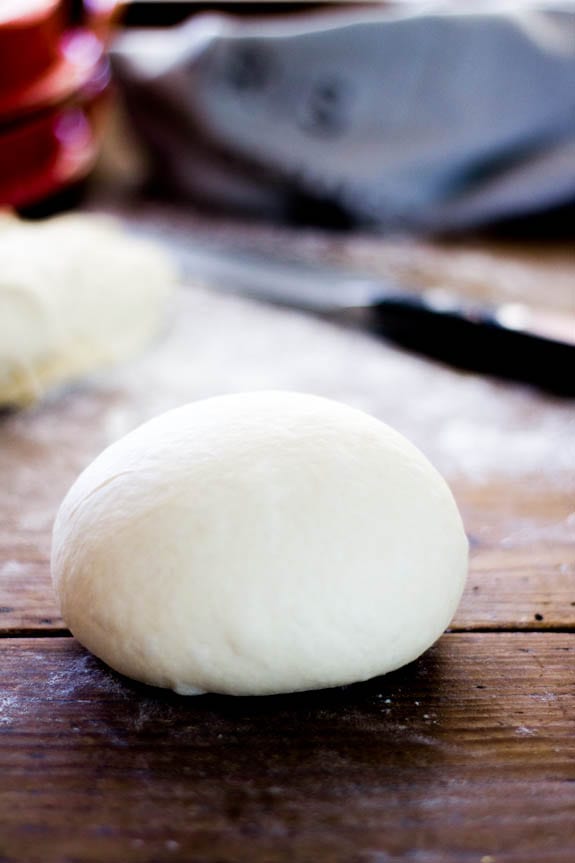
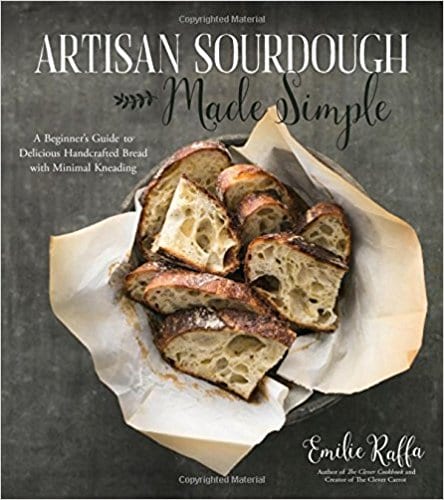


Comments
Lisa says
My first try making sourdough bread was a flop, but I don’t think my starter was quite ready yet. This time I made sure to wait long enough for lots of bubbles on top and used your delicious and easy recipe. I did do the stretch and fold four times before forming the dough. I baked one loaf in my Dutch oven and the other in two a large heavy-duty pot with the lid (oven safe). They all turned out well, but the loaf I cooked in my Dutch oven came out a little too dark. Next time I will bake about 5 minutes less on the last half of the bake. I have a gas oven, so it can be finicky. Thanks for such a great recipe, Emilie!
Emilie Raffa says
Lisa, thanks so much for your feedback! Yes: a super strong starter is key to successful sourdough. No questions asked. Do you have an oven thermometer? This will help with finicky oven temps :)
Sarah Landman says
This is my second time making, the first was a flop. They came out beautifully. I don’t have a dutch oven but used two baking dishes and inverted one on the other, worked perfectly.
Emilie Raffa says
Sarah, this is an excellent tip! I’m glad it worked out this time :)
Crystal says
Hello! My sourdough is pretty much ready to go and I am excited to bake a loaf soon. One question though, after I let it rise overnight, can pause the rising in the fridge and continue the process in the afternoon once I return from work?
Thanks!
Emilie Raffa says
Hi Crystal! Absolutely. During the bulk rise, if you need to step out, cover the bowl with plastic wrap (or with a lid if using a tub or container) and chill until ready to continue later in the day. Timing is flexible at this stage.
Raquel says
OH MY GOD. This is the best recipe ever. I have never made bread before and this was the best. I used the starter recipe and wasn’t sure I was doing it right, but followed it to a T and had nice fluffy/bubbly starter by the 8th day. Used that starter in this recipe…I still wasn’t sure I was doing it right, but read all the comments and kept going….my dough took FOREVER to rise (more than 12 hours) even though I had it in a room that was pretty warm (around 75 degrees), but if I have learned anything about making sourdough it’s that PATIENCE is key and to trust the process. Love love love this recipe. Thank you for making this so simple and easy to follow. I’m excited to continue learning and refining the practice. Thank you for the confidence boost!
Emilie Raffa says
Raquel, thank you SO much. You totally get it: patience is key! Yay! I’m super excited for you. Happy baking :)
Jennifer says
Hey! So first let me say technically my bread was successful. Came out beautiful and overall no issues but, ONE huge one. It lacked flavor- tastes kind of like nothing. What did I do wrong? How can I make it again and rectify this?
My starter was a week old so perhaps that impacts it but, I purchased the 1 ounce of starter from King Arthur Flour and its been very healthy and ready to go for several days. Please help. Thank you so much for such a simple explanation of everything.
Emilie Raffa says
Hi Jennifer! This is a great question. Ok, so contrary to the name, sourdough bread doesn’t always have to be sour. But I recognize that a deep, tangy flavor is a key selling point! Achieving this takes a bit of experimentation. First, make sure your starter is vibrant and strong. This is key. Next, try rising the dough in a warmer environment, say 75-78F. Once it has risen to about 60-70%, shape and do the second rise overnight in the fridge. When done correctly, this method enhance the flavor. Alternatively, you can try replacing a portion of the bread flour with whole wheat flour. About 15% is good to start.
Nancy says
Just made this recipe this morning and it turned out so good. Thank you for all your helpful tips. I will definitely make this again. Yummy! The crust was so crispybut not tough.
Emilie Raffa says
This is so great to hear, Nancy. Thanks for your feedback!
Allanna Voss says
Perhaps my scale is not calibrated or something, but I weighed out the 500g and my dough was not dry or shaggy, it was actually quite sticky. I’ll come back to these comments later when I’m finished baking to let you know how it turned out. Just in case it’s not my scale, is there any other factors that might cause this? This is my second time using this recipe and the first time the dough was definitely dry and shaggy.
Emilie Raffa says
Hi there! Here’s what I’m thinking… if your dough was drier the first time around, and now it’s notably wet, the variable is the amount of water used. In comparison, more was used this time around (scale issues or calculation error). Does that make sense? Also: at what point was the dough sticky? After mixing? Or after the bulk rise? Thanks!
Allanna says
Turns out, it was the brand of bread flour I was using. The first time I made the bread, I used King Arthur. The second (and 2 more times lol) I used Pillsbury’s Best. Today I went back to King Arthur and it was dry and shaggy, just like the first time. L
Martie Eilering says
My bread does not rise at any point and I feel like i am following the directions.
Help my wife is getting frustrated with me.
Emilie Raffa says
Oh no! Hang in there. The issue is usually time, temperature (not warm enough) and/or lack of starter strength. This post will help you out: Why Won’t My Sourdough Bread Rise? Feel free to circle back with additional questions. Thanks!
Martie says
How do I give the starter more strength?
Emilie Raffa says
Feeding your starter on a regular basis will keep your starter strong, healthy and vibrant. Otherwise, your bread won’t rise. The thing about sourdough, is that once you have a starter (whether it was purchased or made from scratch) you can’t just walk away from it. It needs ongoing feedings to maintain its strength. If this sounds completely foreign, this post {linked here} will help, Feeding Sourdough Starter: My Best Tips & Tricks.
Isabelle Lapointe says
I’ve had a starter for months now and tried so many different sourdough recipes and they never quite worked. This is the recipe of my dreams! Great tasting sourdough, great crust without being too hard, air pockets, soft inside, and most of all, so easy!!! I will be keeping this as my one and only recipe! Thanks! :)
Emilie Raffa says
Isabelle, this is SO GREAT to hear. Thanks so much! Enjoy! xx
Patty F says
Hey Emilie
This is my favorite sourdough boule recipe but at times I would like to have the option of putting in frig. Is this possible with this recipe and if so, at what point would I put in frig?
Emilie Raffa says
Hi Patty! Sure thing. Let the dough bulk rise to about 60-70% (not fully doubled), shape, and then place the dough in a floured, cloth-lined proofing basket to chill overnight (about 8-12 hrs). Basically, you’re doing the second rise in the fridge.
Before baking in the morning, inspect the dough… does it look dense? Does it need more time to puff up? If so, rest at room temperature, preferably in a warm spot before baking. Hope this helps!
Damian Robinson says
Oh my, I see at the very end of this post you have the amount of 4 cups of flour, I did not see that until after my post.
I’m very excited I’ve been reading your stuff all day. Thanks
Emilie Raffa says
No worries at all! Great questions. Enjoy Damian!
Damian Robinson says
Hi, making this for the first time tonight. I was given a starter so I’m good to go but my question is: Is 500g of flour enough for a full loaf or even 2? I’ve seen other recipes that call for 5 cups of flour so I’m just checking as they add it after the 4-12 hr rise.
Emilie Raffa says
Hi there! 500 g is plenty for standard-size loaf. For best results in baking, go by weight (not cups); you’ll get better results!
Noenag says
Perfect recipe it comes out just perfect i really want to try on all your recipes
Emilie Raffa says
You are so very kind, thank you! Happy baking, Noenag!
Jennifer K says
How/when is the best way mix in ingredients like onions or cheese?
Emilie Raffa says
Hi Jennifer! Add your mix-ins after the first rest (autolyse step). The dough will be more soft and manageable. You can watch my video here.
Jennifer K says
Thanks!!
Monica says
Can I double this recipe to make a larger loaf? I am using a 6qt dutch oven.
Sonya says
I have tried this from the start and it’s is amazing such an easy explanation of a sourdough bread Thank you so much
Emilie Raffa says
Sonya, thanks for writing. I appreciate the feedback. Enjoy!
Katie Mahoney says
I followed all of the steps and my dough was dry and shaggy but it won’t rise much during the bulk rise. It feels hard still. What should I do
Emilie Raffa says
Hi Katie! For sourdough to rise it needs 3 things: a robust starter, the right temperature and most importantly: time. For your starter, make sure it’s bubbly and active, otherwise your bread dough won’t rise. Do the float test to double check. As for temperature, use warm water in your dough (90-95 F) to give it a boost. Also: leave the dough in a warm spot to rise- 75F+ is ideal. As for time, give it as much time as it needs to rise. Be patient. Always watch the dough and not the clock. More info here: Why Won’t My Sourdough Bread Rise?
Savannah says
Can I use bread pans instead?
Steve Timbrook says
I’ve got a tip for others like me that have cats in the house that have no respect for kitchen counters boundaries. After a few times using a damp cloth to cover the dough bowl between stretch and fold sets and to cover my bulk rise container and having to keep the cats from repurposing the towel as a cat toy, I discovered that I had two pan lids of the perfect sizes to use in place of the cloth. When my dough is resting on the breadboard before shaping and when it’s in the banneton for the 2nd rise I cover the dough with a domed aluminum wok cover. I’ve baked well over a 100 loaves with this technique without any difference that I can tell between using lids and a damp towel except that the cats are no longer being a nuisance when I’m baking.
Emilie Raffa says
Steve, this comment made my day! Excellent tips. I also have a cat who has serious boundary issues. You should see the little paw prints he leaves on my pasta dough sheets…
Steve says
But we love our cats, darn ’em.
Emilie Raffa says
Ha! So true. So very true…
Pam Trent says
My starter gets bubbly but doesn’t rise much. !! What can be going on. Please help. Frustrated and all most want to quit
Emilie Raffa says
Hi Pam! Because your starter is bubbly, it’s possible that it is indeed active, but you might have missed the rise and fall- timing is everything. Have you read these posts? Have a look for additional info: Troubleshooting Your Sourdough Starter & Feeding Sourdough Starter: My Best Tips & Tricks.
Jessica says
I just tasted my first sourdough loaf, it’s 9AM and I am getting my life! This recipe is really easy REALLY tasty. I will say I didn’t know baking bread was basically an all-day event. And that it takes so little starter. I’ve got way too much sourdough starter for the amount it takes to make 1 loaf (beginners mistake). But I’m SO glad I made it!
Emilie Raffa says
So glad you liked it Jessica! Once you get a few loaves under your belt, nailing down a baking schedule that works for you (and doesn’t take up too much time) will naturally follow suit. That’s why I love overnight doughs. Just wake up in the morning and bake! Enjoy xx
clare Ross says
Love this recipe, would like to ask if i can add some seeds like Kalonji seeds as they don’t require soaking. or what other seed would you suggest
Emilie Raffa says
Hi there! Kalonji seeds would be lovely! For other seeds or nuts, I would definitely soak them first. Do this while the dough is resting (autolyse). Cover them in warm water, drain, and pat dry with a paper towel before adding to the dough.
Sue says
Love the information here. Very helpful. 😊
Question: I have followed your recipe and each time my dough comes out very sticky and difficult to manage. Can I just add a bit more flour and will it affect the overall outcome? Thanks
Sue
Emilie Raffa says
Hi Sue! When the dough is sticky, a few things: make sure to weigh your ingredients to ensure the correct amount of water is used. Use a quality bread flour for maximum absorption. Pay attention to the temperature: is it too warm? Finally, observe the rise of the dough… if it goes for too long, it can over proof, turn sticky and then become difficult to manage. You can always add more flour to remedy this. However, I’d first cut back on the amount of water you’re using in your initial mix.
Mia says
Hi,
A friend gifted me some starter from San Francisco. This will be my first go at sourdough baking but since we are a small household of two, I don’t want my effort to go to waste. My question is, can I make dinner sized rolls, par bake them, then freeze them for a quick, easy addition to a meal? If so, how should I go about this?
Any helpful tips would be greatly appreciated, I’m excited to get started!
Emilie Raffa says
Hi there! This is a great question. Par baking with sourdough can be a bit tricky. When frozen, sometimes the sourdough (starter) loses its rising strength. If you are a beginner, and you don’t want your efforts to go to waste, I wouldn’t suggest doing it. Instead, I’d recommend dividing this recipe into two loaves, baking them back to back and freezing whatever you don’t eat. This way, all you have to do is pull out a loaf to defrost. You can even slice the loaf first and then freeze for more flexibility.
Mia says
Thank you 😊
I bought your book and really want to make the dinner rolls, as a roll works perfectly for the types of meals we eat. But I will go ahead and bake them fully before freezing.
Thank you for your reply ☺️
Emilie Raffa says
Mia, you are very welcome! I think you will have better success this way, for sure. Thanks so much for your support :)
Joanna Conley says
Awesome. Made this several times now. Thank you
Emilie Raffa says
You are very welcome, enjoy! xx
sylvie torok-nagy says
Help!
I am attempting to make starter and after 8 says of feeding and resting it’s watery and stinks awful! Not at all appetizing. What have I done wrong? 30g of flour and 30g of water, then stirred together well and covered loosely with plastic wrap and left in a warm place to rest.
Emilie Raffa says
Hi there! The liquid on the surface of your starter paired with a stinky smell is somewhat normal during the feeding process, especially if you let it go for too long in between feedings. To remedy this, I would discard a healthy portion of what you have, and then give it a feed of fresh flour and water to refresh and balance the acidity levels (this will help with the smell). Then don’t wait too long to feed it again. Remember, it will bubble up and then collapse which is your signal to feed it.
sylvie torok-nagy says
Thanks so much! I ended up noticing black mold spores inside the jar and got worried i did it wrong and tossed the whole thing. I will start over with the recipe in your book, as I started it wrong!
Kris Isom says
HI,
Busy making the sourdough starter. On page 9 of the instructions for day 3 and to follow for day 4,5, and 6 it says to remove 60g and I should have 60g left. Add 60g (1/2 cup) of all purpose flour and 60 g (1/4) cup of warm water. So I looked up the conversion for 60g and it is the 1/4 cup or just over 2 ounces. Should I be adding 1/2 cup flour or 1/4 flour.
Thank you in advance for your help. Kris
Bette says
The first live I made turned out amazing! I loved it in too long and the bottom was a little more well done than I had hoped. I’m warming up the oven now for my second loaf with very high hopes! Easy to do, love the measuring by weight and plan to use this recipe indefinitely.
Nancy says
Is there an adjustment that needs to be made when preparing this recipe in a high altitude area?
Kirstin says
Is it possible to use a 3qt dutch oven? Would I have to halve the recipe in order for it to fit into a smaller dutch oven?
Mariannecorriere says
Yes I believe you would. I use a 5 quart for one loaf using the full ball of dough and I don’t see it fitting in anything smaller.
Kendra says
I split the recipe into 2 loaves and cook one in my 2.75qt Dutch oven and another in my 8qt. I actually prefer the way the smaller Dutch oven comes out!
Cathy says
Hi there,
Just a question, with the second rise only being 30mins to 1 hour, does it matter if the second rise goes for longer?
So say I do my bulk rise and my dough has risen, so due to it being night-time I put the dough in the fridge overnight to bake the next day.
What would you do in this instance, once I remove my dough the following day from the fridge how long do you think my second rise should go for?
Thankyou so much
Cathy x
Marianne says
My second rise (or first for that matter) always takes longer than 30-60 minutes – especially if it’s cold – and it turns out fine. Like Emilie says, watch the dough not the clock. 👍
Marianne says
I am super excited. I am making this recipe for the first time (my second experience making sourdough bread). I just took the lid off – and it looks AMAZING! I was afraid I might have messed it up by putting the dough into the fridge overnight after a nearly 12 hour bulk rise, but I needn’t have worried. It looks so much better than I expected! I can hardly wait to take it out of the oven. 😍
Marianne says
The verdict: This recipe is a winner! The crust is chewy but not overly so, soft and moist on the inside and even though the bottom was extremely dark, it wasn’t difficult to cut through. It smells divine and tastes more sour (a plus!) than my first attempt using a different recipe. This time I used a rye starter instead of AP flour starter. I’m so thrilled with the results. I plan to make your Sourdough sandwich bread next.
Emilie Raffa says
Marianne, thank you so much for your thoughtful & thorough feedback on this post (and others!). It’s great to see you get on with sourdough baking!
Marianne says
Thank you! I’m enjoying it so much that I’m kicking myself for not trying 25 years ago because it seemed “too hard”. Once you get the hang of it, I think it’s even easier than yeast bread because its much less hands on, and you can throw it in the fridge until the following day if it takes too long to rise. Plus, the taste and texture is amazing. 😊
Shea says
I’ve made a few different recipes with lackluster results. Just tried this recipe and I think it will be the only one I use from now on! The instructions were easy to follow and the loaf it made was amazing. I like that it uses more g’s of starter and you don’t need to preheat your dutch oven like some other recipes call for. Thanks again!
Emilie Raffa says
Thank you Shea! I’m glad you had success with the recipe :)
Eileen says
Hi! I wanted to know how you remove the baked bread from a Dutch oven? I am choosing between purchasing a Le Creuset dutch oven( multiple uses) or the Challenger bread pan.
Marianne says
Hi Eileen…personally I would go with something that has more than one use. I remove it by lifting it out with the type of spatula used for flipping pancakes. Or you could lift it out by the edges of the parchment paper if the paper extends a couple inches up the sides of the pot. Hope that helps.
Emilie Raffa says
Hi Eileen! To remove bread from a Dutch oven, I use the parchment paper to lift the loaf up and out. It’s the easiest. Like Marianne mentioned, a large spatula will work too. As for the Challenger Bread Pan, you just remove the lid and take out the bread; it does not have high sides like the Dutch oven.
Kelly Hitchcock says
When should I see results of my first starter?
Emilie Raffa says
Hi Kelly! When creating a starter from scratch, about 7-14 days should be expected. The biggest variable that slows things down is temperature. Starters love warmth. The ideal temp. should be 75-78 F for bubbly fermentation.
Kelly Hitchcock says
How do a convert gram to fluid oz?
Marianne says
I got an inexpensive digital scale on Amazon that has grams, ounces, kilograms, etc. I highly recommend getting one.
Betsy says
I use a kitchen scale from brambleberry or one from Amazon…I make cold process soap. I also have gotten one from Walmart. Just be sure it has ounces and grams. Hope this helps too!
Caroline Stewart says
I’ve been using this recipe for a few months now with varying success. Flavour always great though. I have a couple of questions.
During my free form second rise my boule spreads. I’m worried about using a bowl in case I knock all the air out when I’m transferring it. Could I try reducing water content?
Second question. I’m using a Dutch oven which produces much better results. I’ve been.using it upside down so doing my second prove on the lid and preheating the large part because I don’t want burnt wrists. This works ok but should I consider leaving the lid (the bottom of the pan) on longer as it feels like the loaf is crisping up too much.
Thanks
Emilie Raffa says
Hello Caroline! Using a bowl or proofing basket is your best bet to prevent the dough from spreading. However, reducing the water can in fact help; how much are you currently using? As for the pan, yes: you can leave the lid on longer for a softer crust. You can also wrap the finished baked loaf in a kitchen towel to soften the texture when it cools.
Caroline Stewart says
I am using your recipe which is 250g of water but I’ve reduced it to 230g. Still spreads but I rarely do stretch and fold which could also help. Thanks for your reply.
brian Stephen Williams says
Excellent recipe, thank you. Should I use the same recipe for pizzas and would it be better to use pizza flour?
Emilie Raffa says
Hi there! This is a great question. For pizza, the dough can be used with an increased amount of water (350-375g) for best texture. Alternatively, pizza flour can be used. If it’s a fine milled “00” flour add a smaller amount of water and work your way up. All flours are different; they absorb water at different rates.
Bunny says
Thank you. I made sourdough bread for the first time. Your instructions were easy to follow. My bread came out moist, good crust and tender.
Emilie Raffa says
Excellent! So great to hear. Happy baking!
Mike says
Hi there! I’m new to Sourdough bread making. Does this recipe makes a 2 lb loaf and what size proving basket would you recommend? Thanks!
Kristin says
Hi Emilie: Thank you for your sourdough recipes. They are wonderful. I have read through all your questions snd comments because I have used your recipe for sourdough using bread flour snd all purpose. You explain the difference between the two types of flours snd state that all purpose absorbs less water and therefore need the water reduced. After making both recipe I notice that the all purpose artisan sourdough calls for more water 330 g instead of the 250 g for bread flour. I did notice the all purpose was more sticky- due to extra water? So in retrospect I’m a bit confused. Should the artisan bread with all purpose flour use 330g water? Thank you for clarification.
Laura O'Meara says
Thank you for the great recipe and instructions. My family loved this bread :)
Emilie Raffa says
You’re very welcome! Enjoy!
Dreama says
It was awesome! Mine did not have a very sour taste, but it was delicious. Hiw would I remedy that? Also, what is the nutritional facts?
Emilie Raffa says
Hi there! Developing a deeper “sour” flavor comes from a variety of factors and experimentation. You can try one (or more) of the following: maintain a more acidic starter; use a small portion of whole grain flour in the dough (you’ll need to add more water to compensate; and/or try rising the dough in a warm spot during the day followed by an overnight second rise in the fridge.
S Larson says
I used a teaspoon of sour salt because I love extra sour sourdough bread. Be careful, it’s very sour. One teaspoon is very sour. If you want just a little more sour 1/2 a teaspoon should do fine.
Marianne says
I have made this twice; once with rye starter which turned out nice and sour and once with all purpose starter which wasn’t very sour at all. I prefer it sour so will use rye from now on. The only complaint I have about using rye is the bread takes on a color that doesn’t look super appealing but I can live with that.
C says
Any chance to add in additional measurements besides grams? This is a recipe I would like to try, but really turned off by just gram measurements.
TraperD says
You can get kitchen scales from Amazon that do both imperial and metric weights. They are not very expensive and easy to use.
LM says
3/4 cup bubbly, active starter
1 cup + 1 tbsp warm water
2 tbsp olive oil
4 cups bread flour
1 1/2 tsp fine sea salt
Emilie Raffa says
Hi there! You can find the measurements (with additional explanation) in the FAQ Section at the bottom of the post. Thanks!
Cindy Dracobly says
I noticed this beginner recipe calls for olive oil. The recipe in the book does not use olive oil. Which do you recommend? I just made the sour dough English muffins. They rose nicely but lacked “air holes”. Do you have any recommendations?
Emilie Raffa says
Hi there! They are just two different recipes. Olive oil is used here for variation. The interior crumb becomes more plush, especially when used in a drier, low hydration dough like this one. It’s up to you what you’d like to do! Re: the English Muffins, make sure the gluten is adequately developed (sounds like this was already the case for you) and make sure the dough has puffed up during the second rise. If not, give it more time to aerate.
Betsy Gast says
My summer temperatures exceed 100F! Can I still do this bread? I live in Arizona and want to bake, but it’s so hot! Can I maybe use the gas grill on indirect heat to bake? Have you heard of doing it this way? I am a newbie, so any help would be appreciated!
Betsy
Emilie Raffa says
Hi Betsy! In your case, to beat the heat, make the dough and chill when almost double in size (overnight). In the early morning, bake the dough when it’s still somewhat cool. I’ve never done it on a grill! Can it fit with the Dutch oven? If you experiment, please let us know!
Betsy says
I keep trying to make the recipe, but it is coming out dense! Crumb texture is great but it’s not very sour…is my starter still too new? I freeze my discard because I have a pink slime mold problem and this gives me a start again. The first time I used the frozen starter was great…the second time it’s extremely thick. What am I doing wrong?
Emilie Raffa says
Hi Betsy! To clarify: are you making this bread with discard or active sourdough starter? Thanks!
Brandon says
Overall, this recipe has helped me the most. Initially I looked at a few other recipes online to get started but kept coming back to this one. For a beginner like me this recipe is excellent. I have since used it as a base line to experiment with different hydration and times for proofing. Thank you so much for providing a great recipe and good information.
Emilie Raffa says
That’s wonderful to hear. Thanks so much Brandon!
hunter says
I put my dough in the fridge during the bulk rise because I wasn’t ready yet to bake. Now I’ve shaped it and am waiting to throw it in the oven, but it’s been an hour and it’s still kind of cold and dense. Will report back after baking but I’m going to give it some more time. It says the dough should be puffy and not dense, but it’s still dense. Hoping this doesn’t overprove the dough as it’s bouncing back less when I poke into it.
Jean says
The instructions here has made this experience remarkable. Thank you.
Janice says
The best recipe for sourdough beginner like myself! Explanations are clear with video references. I find it really easy to follow and the result of the sourdough is simply amazing… now my friends and family all eat homemade sourdough only. FYI I stay in a humid and hot weather in singapore and for me proofing over night makes the bread too sour. I adjust my proof time to 7-8 hours!